A world of miniature botanical wonders awaits at your fingertips. You’ll discover that tiny succulents, most under 3 inches tall, can transform any modest space into a flourishing indoor garden. From the peculiar Living Stone Succulent, which perfectly mimics small pebbles, to the pearly translucent orbs of the Pearl Plant, these compact beauties offer endless possibilities for creative display. Let’s explore which petite succulents will best suit your space and lifestyle.
Contents
- 1 1. Living Stone Succulents
- 2 2. Button Cactus
- 3 3. Pearl Plant
- 4 4. Baby Toes Succulent
- 5 5. Miniature Jade Plant
- 6 6. String of Hearts Succulent
- 7 7. Pink Moonstones Succulent
- 8 8. Bunny Ear Cactus, Miniature
- 9 9. Tiny Tiger Jaw Succulent
- 10 10. Miniature Haworthia Zebra Plant
- 11 11. Chinese Dunce Cap Succulent
- 12 12. Ruby Ball Cactus
- 13 13. Blue Chalksticks Succulent
- 14 14. Pincushion Cactus
- 15 15. Mexican Snowball Cactus
1. Living Stone Succulents
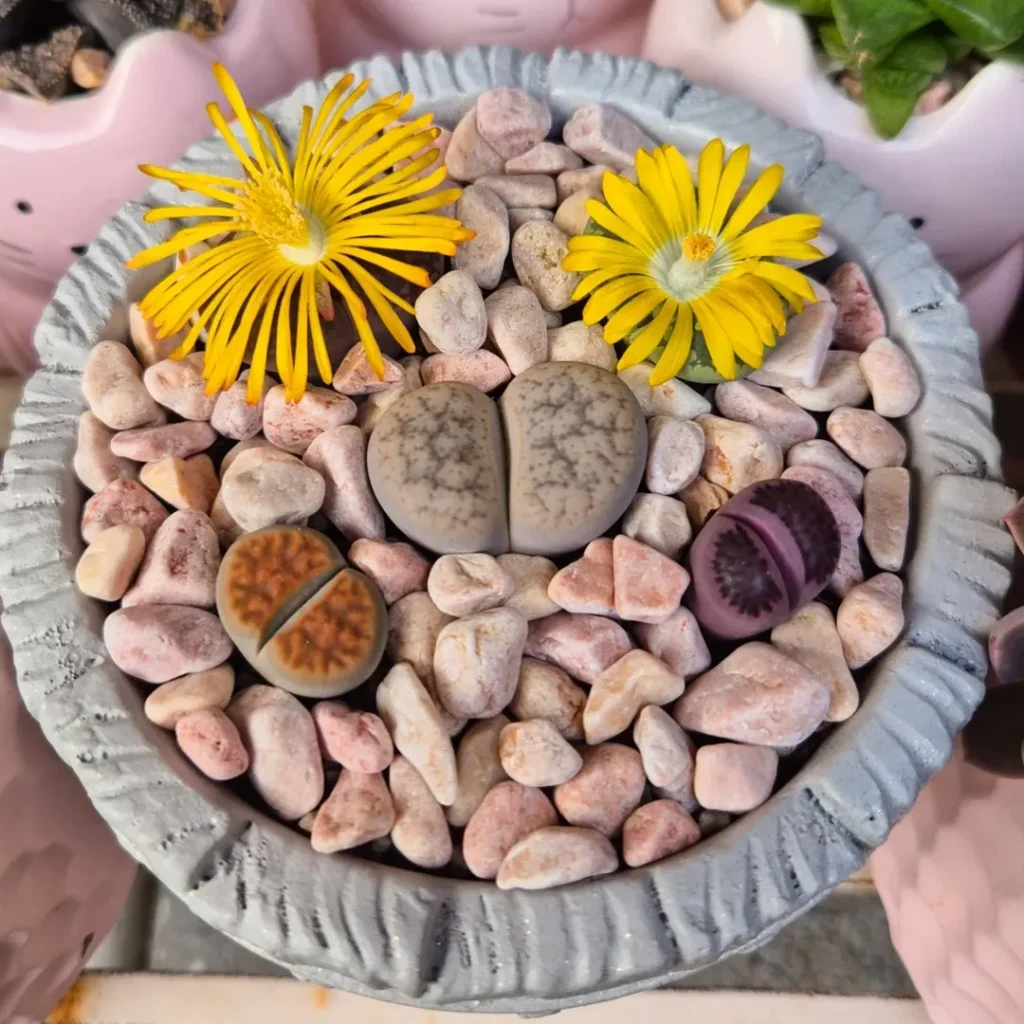
Living Stone succulents (Lithops) are fascinating tiny plants that have evolved to resemble pebbles or stones as a form of natural camouflage. These small succulents typically grow no more than an inch or two in height and consist of a pair of thick, fleshy leaves that are split by a fissure in the middle. Native to the desert regions of southern Africa, Living Stones come in various colors and patterns, ranging from grayish-green to brown, often with speckled or mottled surfaces that help them blend in with their natural surroundings.
- Light: Bright indirect to full sun; at least 4-5 hours of direct sunlight daily
- Water: Minimal watering; water thoroughly only when completely dry, usually every 2-3 weeks in growing season; almost no water in winter
- Soil: Very well-draining mixture; 75-80% mineral grit (pumice, coarse sand) with 20-25% organic matter
- Temperature: Prefer 65-80°F (18-27°C); can tolerate brief periods of cooler temperatures
- Humidity: Low humidity; desert-like conditions
- Container: Small, shallow pot with drainage holes
- Fertilizer: Very light feeding during growing season; none during dormancy
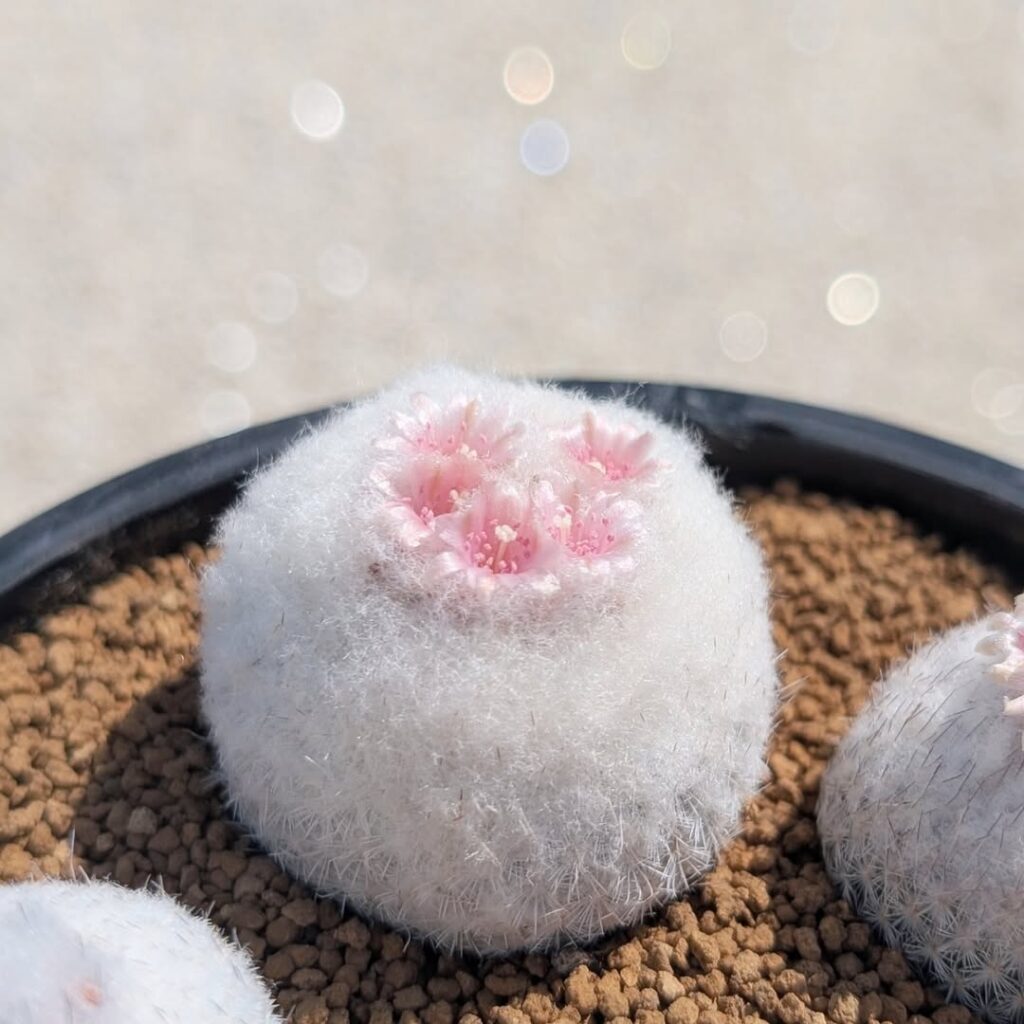
The Button Cactus (Epithelantha micromeris) is a miniature, spherical cactus native to Mexico and Texas that typically grows to only 1-2 inches in diameter. This diminutive succulent features densely packed, spiral-arranged white spines covering its surface, giving it a fuzzy, button-like appearance. The plant produces small pink or whitish flowers in spring, followed by elongated red fruits, though flowering is rare in cultivation. Its compact size makes it an excellent choice for small containers and dish gardens.
- Light: Full sun to partial shade; protect from intense afternoon sun in hot climates
- Water: Minimal water needed; allow soil to dry completely between waterings
- Soil: Well-draining cactus mix with added mineral grit (pumice or perlite)
- Temperature: Prefers warm conditions but can tolerate brief periods down to 20°F (-6°C)
- Humidity: Low humidity; tolerates dry conditions well
- Fertilizer: Light feeding during growing season with diluted cactus fertilizer
- Container: Small, shallow pot with drainage holes
3. Pearl Plant
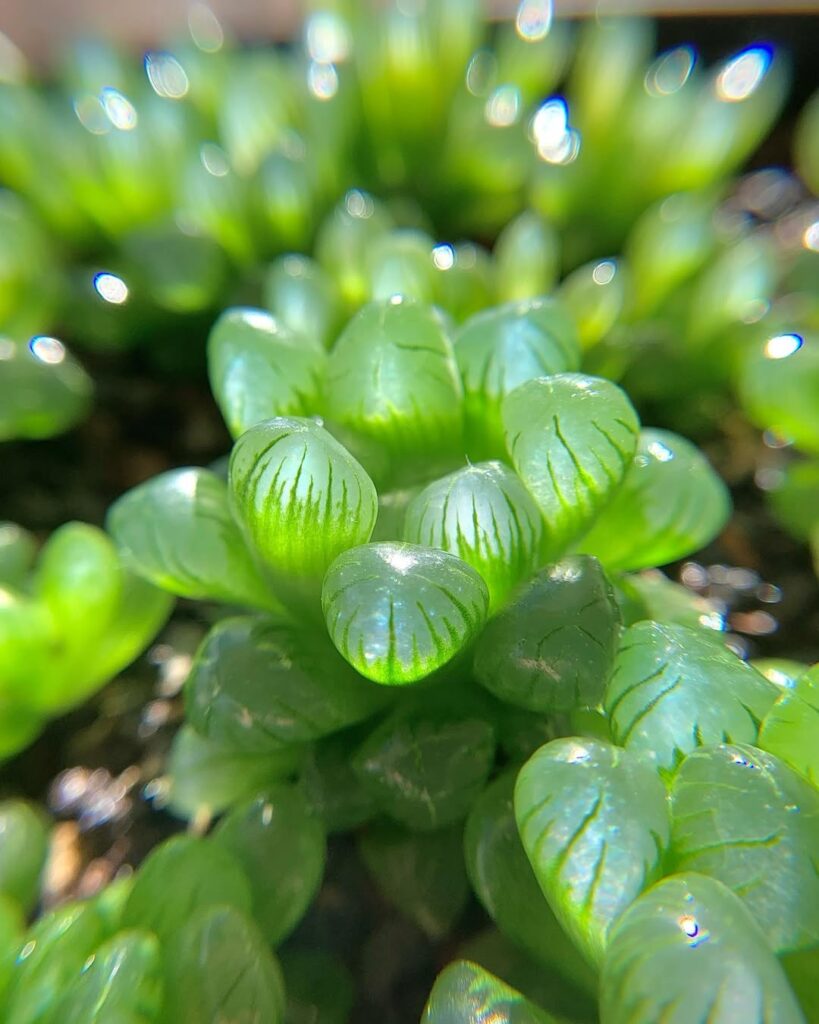
The Pearl Plant (Haworthia cooperi) is a small, clump-forming succulent known for its distinctive translucent leaves that resemble tiny pearls or jewels. Each rosette grows to about 3 inches in diameter and features fleshy, rounded leaf tips that allow light to pass through, creating a luminous effect. This compact succulent is native to South Africa and makes an excellent choice for indoor growing, particularly in terrariums or as a windowsill plant.
- Light: Bright indirect sunlight; protect from intense afternoon sun to prevent leaf burn
- Water: Allow soil to dry completely between waterings; reduce watering in winter
- Soil: Well-draining succulent or cactus mix
- Temperature: 65-80°F (18-27°C); can tolerate brief periods of cooler temperatures
- Humidity: Tolerates normal household humidity levels
- Container: Small pot with drainage holes
- Fertilizer: Light feeding with balanced fertilizer during growing season
- Propagation: Via offsets or leaf cuttings
4. Baby Toes Succulent
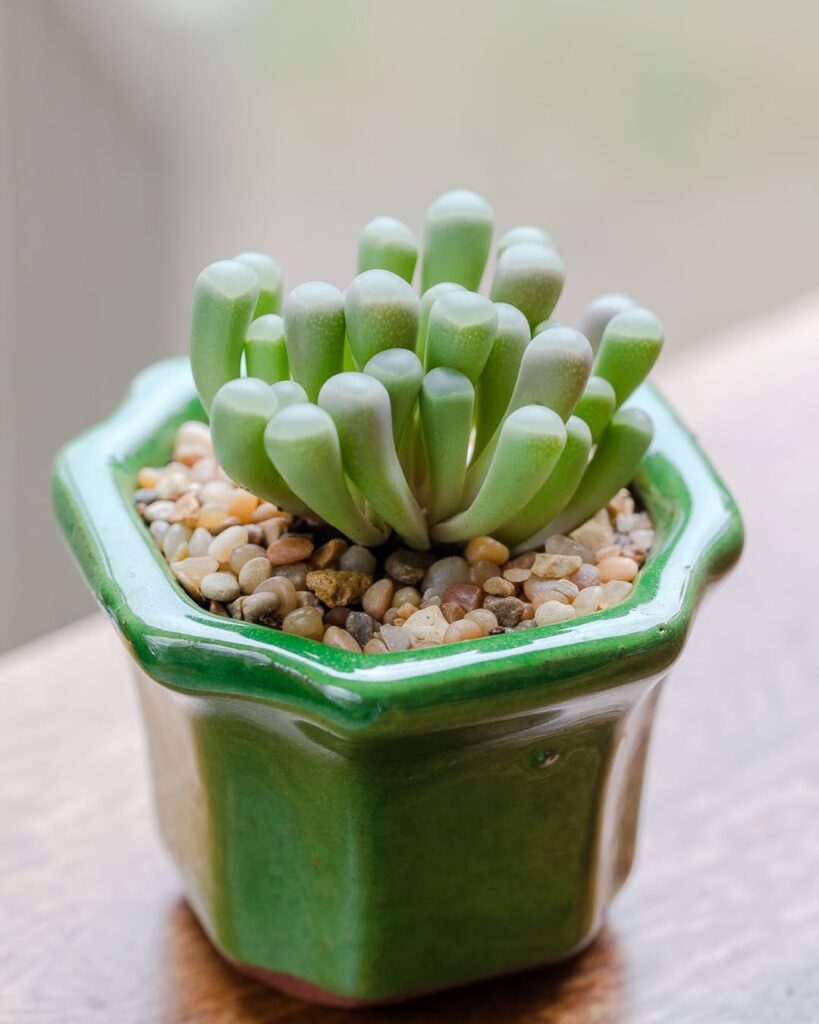
Baby Toes (Fenestraria rhopalophylla) is a small, unique succulent native to South Africa that gets its common name from its distinctive appearance – clusters of upright, cylindrical leaves that resemble tiny toes. Each leaf has a flat, translucent “window” at the tip that allows light to penetrate deeper into the leaf tissue, helping the plant photosynthesize while remaining mostly buried in its natural habitat. The succulent produces white or yellow daisy-like flowers when mature, typically blooming in late winter to early spring.
- Light: Full sun to partial shade; at least 6 hours of direct sunlight daily
- Water: Low water needs; water thoroughly when soil is completely dry
- Soil: Well-draining sandy or gritty soil mix
- Temperature: 65-80°F (18-27°C); not frost tolerant
- Humidity: Low humidity preferred
- Fertilizer: Light feeding during growing season with diluted succulent fertilizer
- Potting: Shallow containers with drainage holes
- Growing Season: Active growth in spring and fall
- Dormancy: Semi-dormant in summer and winter
5. Miniature Jade Plant
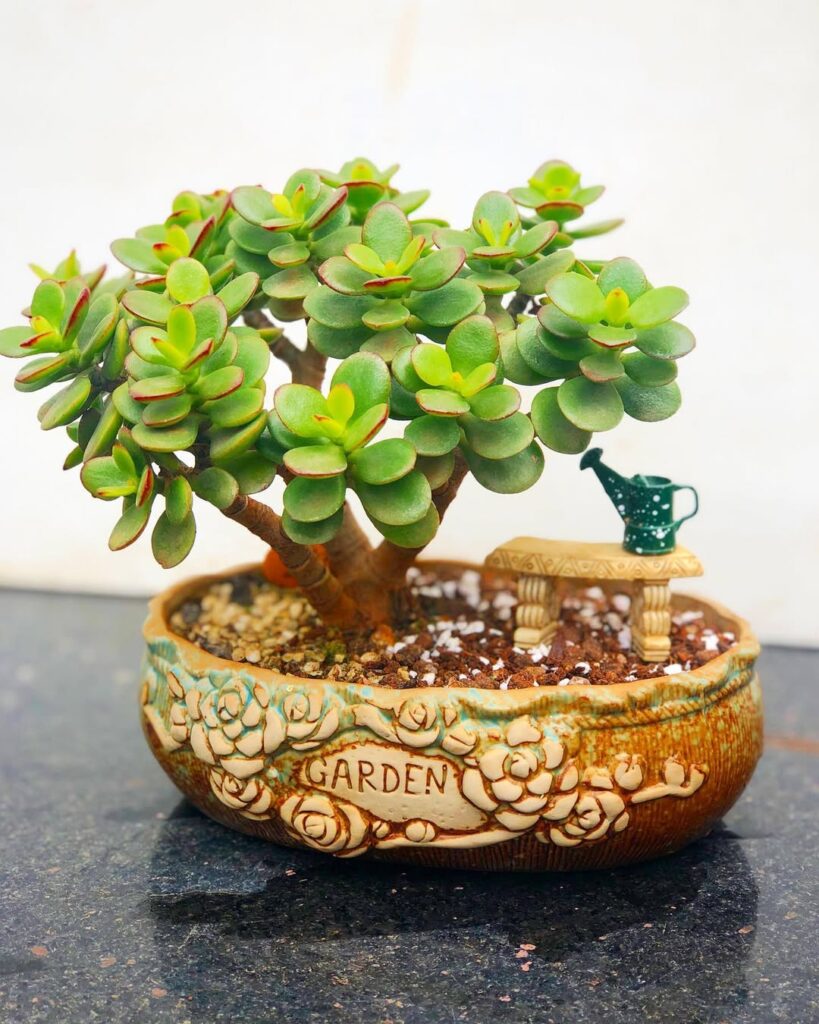
The Miniature Jade Plant (Crassula ovata ‘Minima’) is a compact version of the classic Jade Plant, typically growing only 6-12 inches tall. This slow-growing succulent features thick, oval-shaped leaves that are a glossy deep green color and grow in opposing pairs along woody stems. Like its larger counterpart, it can develop a tree-like appearance over time, making it an excellent choice for bonsai enthusiasts and those seeking a manageable indoor succulent.
- Light: Bright indirect light with some direct morning sun; protect from harsh afternoon sun
- Water: Allow soil to dry completely between waterings; reduce watering in winter
- Soil: Well-draining cactus or succulent mix
- Temperature: 65-75°F (18-24°C); can tolerate down to 50°F (10°C)
- Humidity: Tolerates average home humidity; prefers dry conditions
- Container: Small pot with drainage holes
- Fertilizer: Light feeding with balanced fertilizer during growing season
- Propagation: Easily propagated through leaf or stem cuttings
6. String of Hearts Succulent
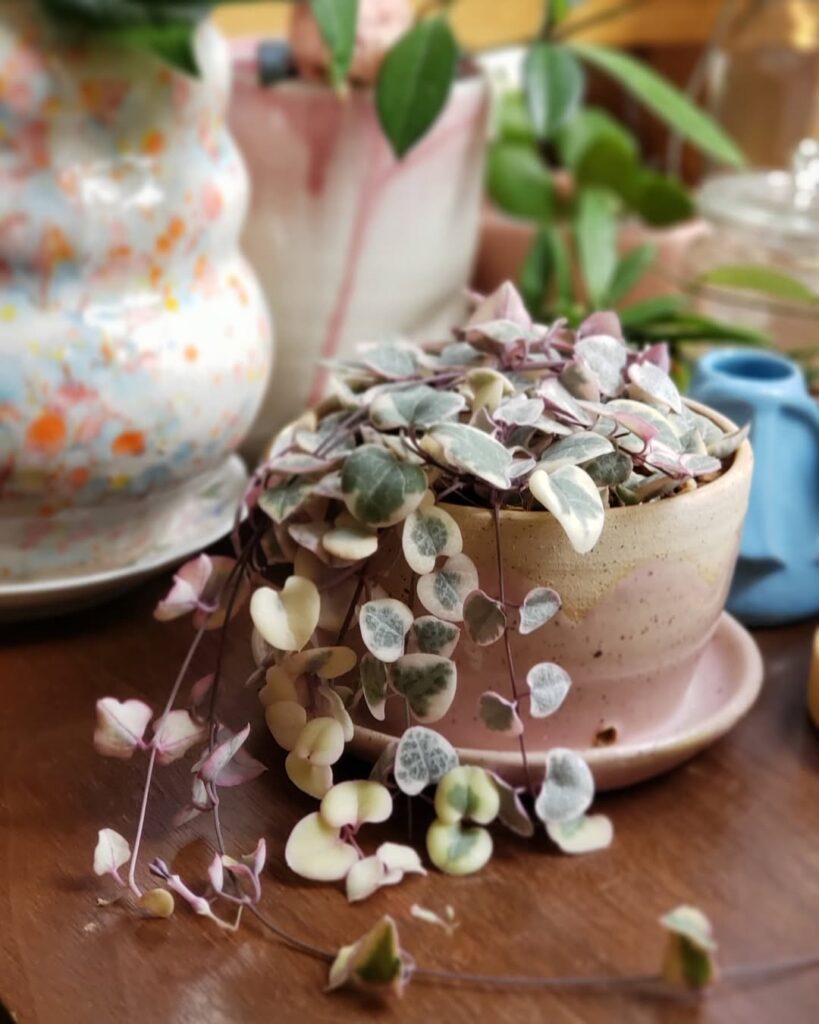
The String of Hearts (Ceropegia woodii) is a delicate trailing succulent known for its distinctive heart-shaped leaves and long, thin vines that can grow several feet in length. Its leaves are small, fleshy, and variegated with silver marbling on dark green, while the undersides display a purple hue. The plant produces unique tubular flowers in pink or purple shades, though they’re relatively inconspicuous. Native to South Africa, this succulent has become a popular houseplant due to its charming appearance and relatively easy care requirements.
- Light: Bright, indirect sunlight; can tolerate some direct morning sun; protect from intense afternoon sun
- Water: Allow soil to dry between waterings; reduce watering in winter; susceptible to root rot if overwatered
- Soil: Well-draining succulent or cactus mix; add perlite or sand for better drainage
- Temperature: Thrives in 65-80°F (18-27°C); protect from cold drafts
- Humidity: Tolerates average household humidity levels
- Container: Use pots with drainage holes; hanging baskets or elevated pots work well to showcase trailing vines
- Fertilizer: Feed with diluted succulent fertilizer during growing season (spring and summer)
7. Pink Moonstones Succulent
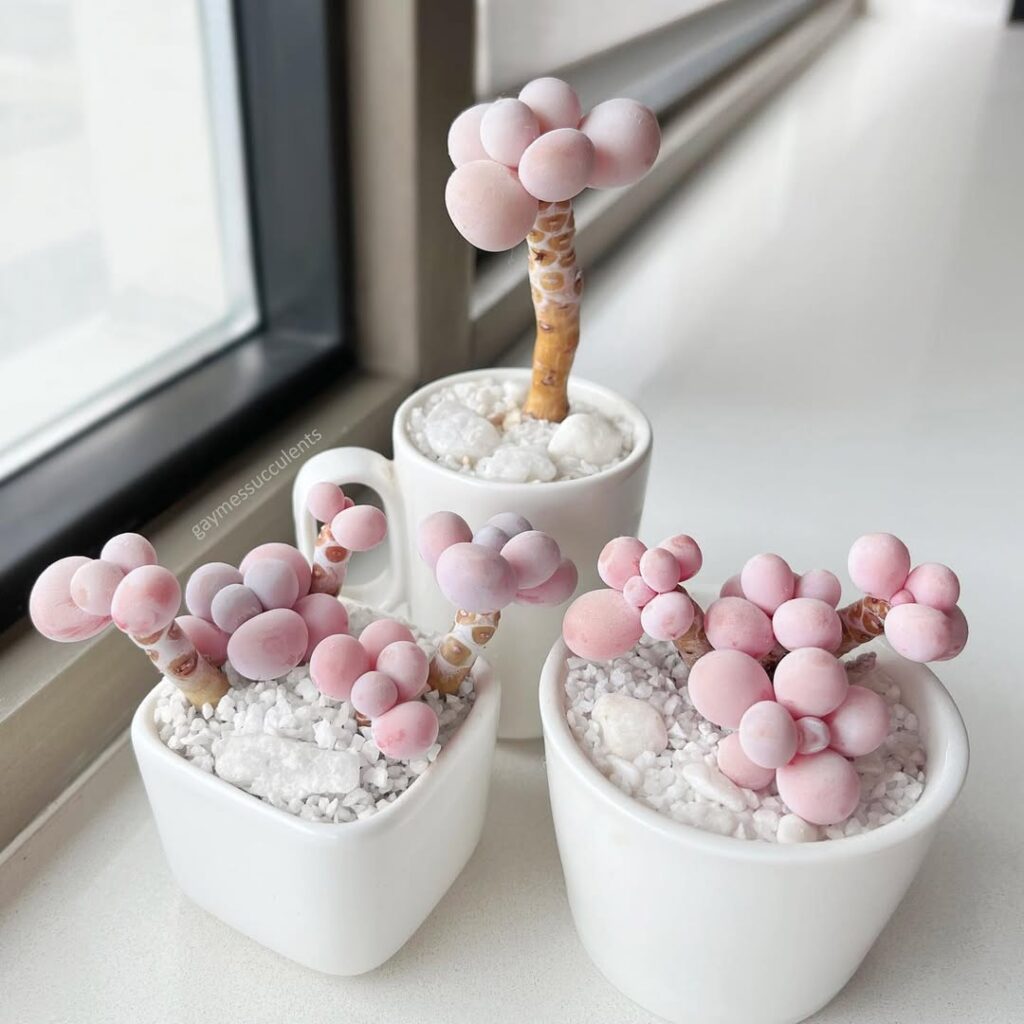
Pink Moonstones (Pachyphytum oviferum) is a charming, rosette-forming succulent known for its plump, oval-shaped leaves that showcase a soft pink to bluish-gray hue with a powdery coating. This coating, called farina, gives the plant an ethereal, moon-like appearance that inspired its common name. The leaves grow in a spiral pattern, creating a compact rosette that typically reaches 3-6 inches in height, making it an excellent choice for container gardens and rock gardens.
- Light: Bright, indirect sunlight with some morning direct sun; protect from intense afternoon sun to prevent leaf burn
- Water: Water thoroughly when soil is completely dry; reduce watering in winter months
- Soil: Well-draining cactus or succulent mix with added perlite or pumice
- Temperature: Thrives in 65-80°F (18-27°C); protect from frost
- Humidity: Low humidity preferred; tolerates average household humidity
- Fertilizer: Light feeding with balanced succulent fertilizer during growing season
- Container: Pot with drainage holes to prevent root rot
- Propagation: Easily propagated through leaf cuttings or offsets
8. Bunny Ear Cactus, Miniature
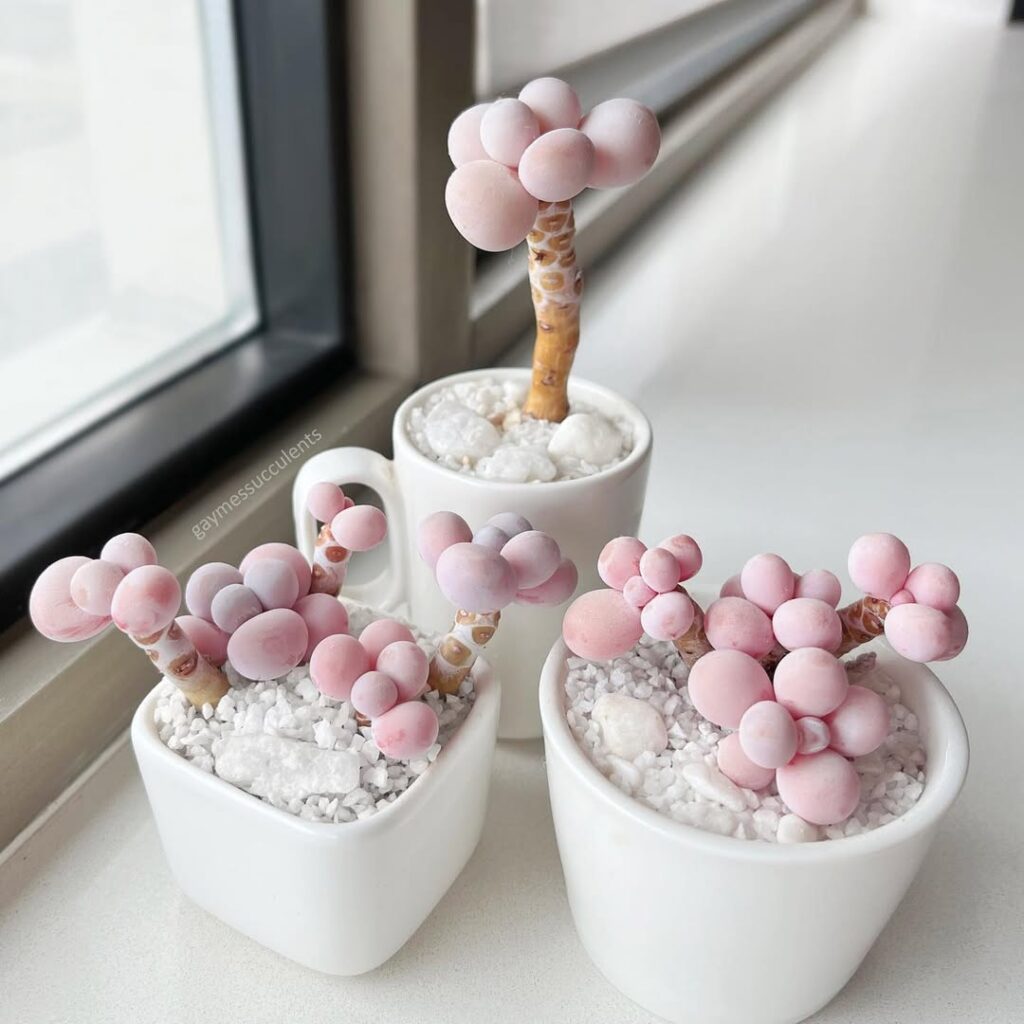
The Bunny Ear Cactus (Opuntia microdasys), also known as Polka Dot Cactus, is a compact, miniature variety that grows to about 2-3 feet tall. It features distinctive oval-shaped pads covered in clusters of small, white, fuzzy glochids that resemble polka dots. Unlike many other cacti, this species lacks large spines but the glochids can still irritate skin if touched. The pads grow in pairs, creating the appearance of rabbit ears, hence its common name.
- Light: Bright, direct sunlight for 6+ hours daily; can tolerate partial shade
- Water: Allow soil to dry completely between waterings; reduce watering in winter
- Soil: Well-draining cactus mix or regular potting soil mixed with sand and perlite
- Temperature: 70-100°F (21-38°C); protect from frost
- Humidity: Low humidity preferred
- Container: Small pot with drainage holes
- Fertilizer: Light feeding with cactus fertilizer during growing season
- Growing Zone: USDA zones 9-11
9. Tiny Tiger Jaw Succulent
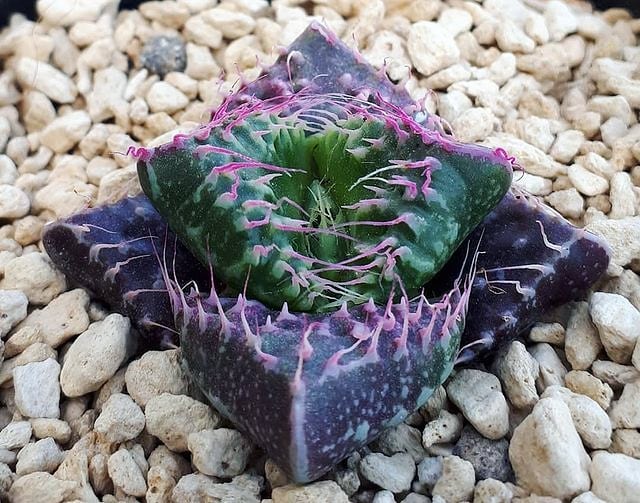
The Tiny Tiger Jaw (Faucaria tigrina) is a miniature succulent known for its distinctive triangular leaves featuring soft, white teeth along the edges, resembling a tiger’s jaw. This compact plant typically grows to only 2-3 inches in height and forms small clusters of rosettes. Each leaf pair has rows of raised bumps or “teeth” that give it its unique appearance, and during fall or winter, the plant produces yellow daisy-like flowers that emerge from between the leaf pairs.
- Light: Bright indirect sunlight to full sun; at least 6 hours of sunlight daily
- Water: Allow soil to dry completely between waterings; reduce watering in winter
- Soil: Well-draining cactus or succulent mix with added perlite
- Temperature: 65-80°F (18-27°C); protect from frost
- Humidity: Low humidity preferred
- Container: Small pot with drainage holes
- Fertilizer: Light feeding with diluted succulent fertilizer during growing season
- Propagation: Through division of offsets or seeds
10. Miniature Haworthia Zebra Plant
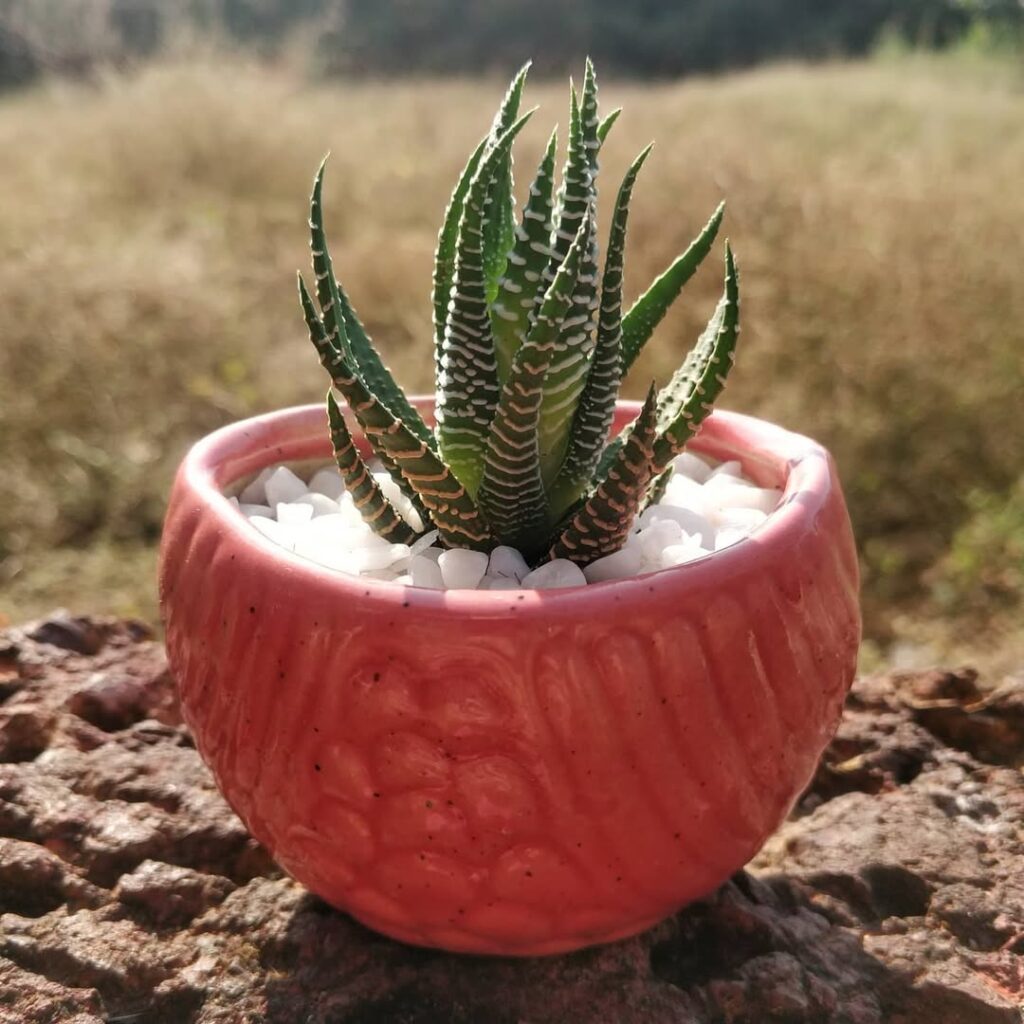
The Miniature Haworthia Zebra Plant (Haworthia fasciata) is a small, slow-growing succulent that typically reaches only 3-5 inches in height. Known for its distinctive white stripes on dark green leaves arranged in a rosette pattern, this compact plant features thick, triangular leaves with raised white tubercles on the outer surface. Its petite size and striking appearance make it an excellent choice for windowsills, desk gardens, and small indoor spaces.
- Light: Bright indirect sunlight; avoid harsh afternoon sun; can tolerate partial shade
- Water: Allow soil to dry completely between waterings; reduce watering in winter
- Soil: Well-draining cactus or succulent mix with added perlite or sand
- Temperature: 65-80°F (18-27°C); can tolerate brief periods of cooler temperatures
- Humidity: Low to moderate; tolerates typical indoor humidity levels
- Pot Requirements: Small container with drainage holes
- Fertilizer: Light feeding with balanced fertilizer during growing season (spring/summer)
- Growing Zone: USDA zones 9-11 for outdoor growth
11. Chinese Dunce Cap Succulent
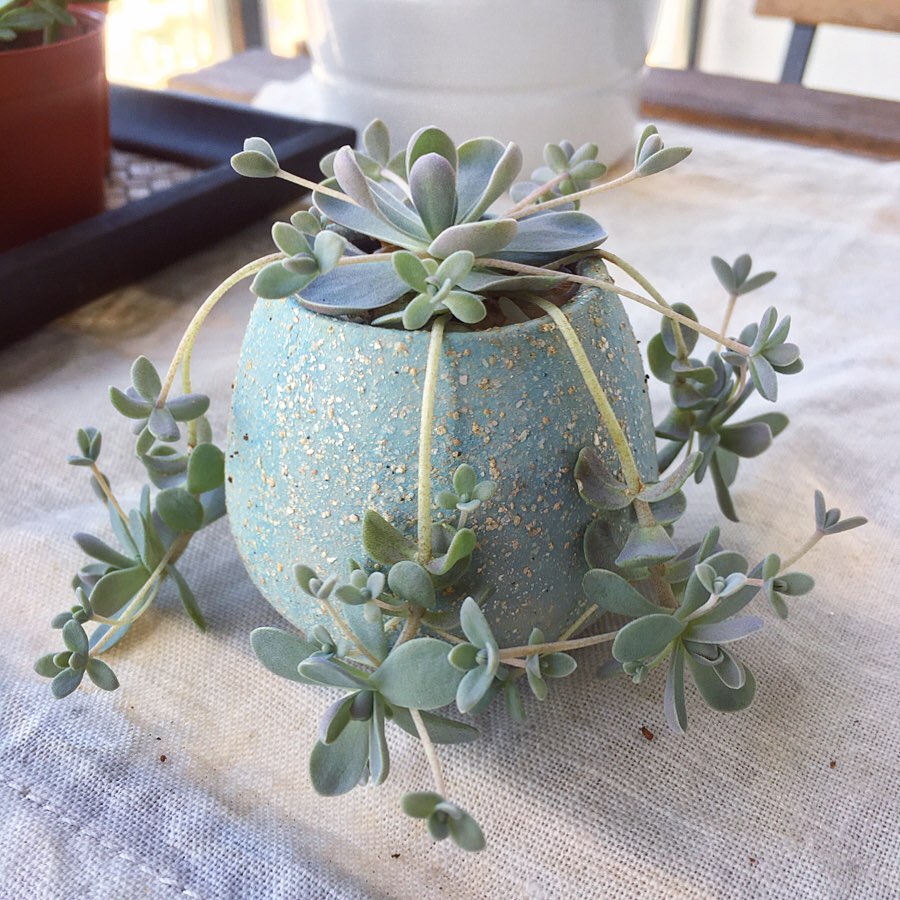
The Chinese Dunce Cap (Orostachys iwarenge) is a small, rosette-forming succulent that gets its common name from its distinctive cone-shaped flower stalks. This hardy plant features tight clusters of pale blue-green to silvery leaves arranged in geometric spirals, creating a symmetrical appearance. As it matures, the rosette produces tall flowering spikes with small white or pink blossoms in late summer to fall, after which the parent plant dies but leaves behind numerous offsets to continue the growth cycle.
- Light: Bright, indirect sunlight; can tolerate partial shade but needs some direct sun for ideal growth
- Water: Moderate watering during growing season; reduce considerably in winter; allow soil to dry between waterings
- Soil: Well-draining cactus or succulent mix
- Temperature: Hardy in zones 5-9; tolerates cold better than most succulents
- Humidity: Low to moderate; adapts well to average household conditions
- Container: Shallow pot with drainage holes
- Fertilizer: Light feeding with balanced fertilizer during growing season
- Propagation: Easily propagated through offsets or leaf cuttings
12. Ruby Ball Cactus
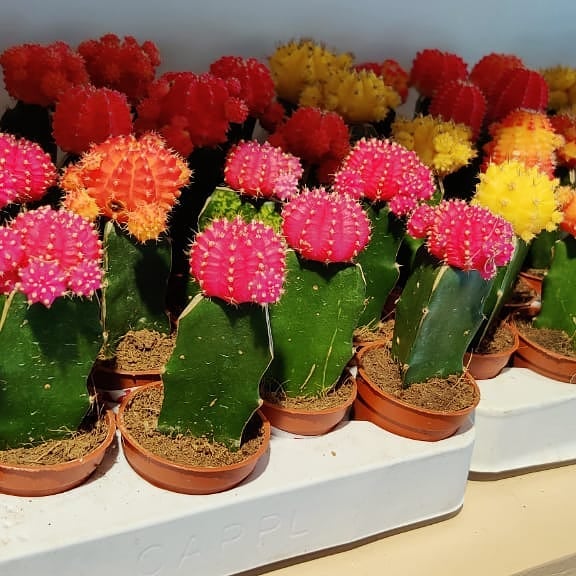
The Ruby Ball Cactus, also known as Red Cap Cactus or Moon Cactus, is a colorful grafted succulent combining two different cacti species. The top portion is typically a Gymnocalycium mihanovichii mutant that lacks chlorophyll and displays vibrant colors like red, orange, yellow, or pink, while the bottom green portion is usually a Hylocereus cactus that provides necessary nutrients. Due to its grafted nature, these plants typically have a shorter lifespan of 1-3 years, though with proper care they can sometimes last longer.
- Light: Bright, indirect sunlight; protect from intense afternoon sun to prevent color fading
- Water: Allow soil to dry completely between waterings; reduce watering in winter
- Soil: Well-draining cactus mix with added perlite or sand
- Temperature: 70-80°F (21-27°C); keep above 60°F (16°C)
- Humidity: Low to moderate; tolerates typical indoor humidity levels
- Fertilizer: Feed with diluted cactus fertilizer during growing season only
- Container: Small pot with drainage holes; repot only when necessary
13. Blue Chalksticks Succulent
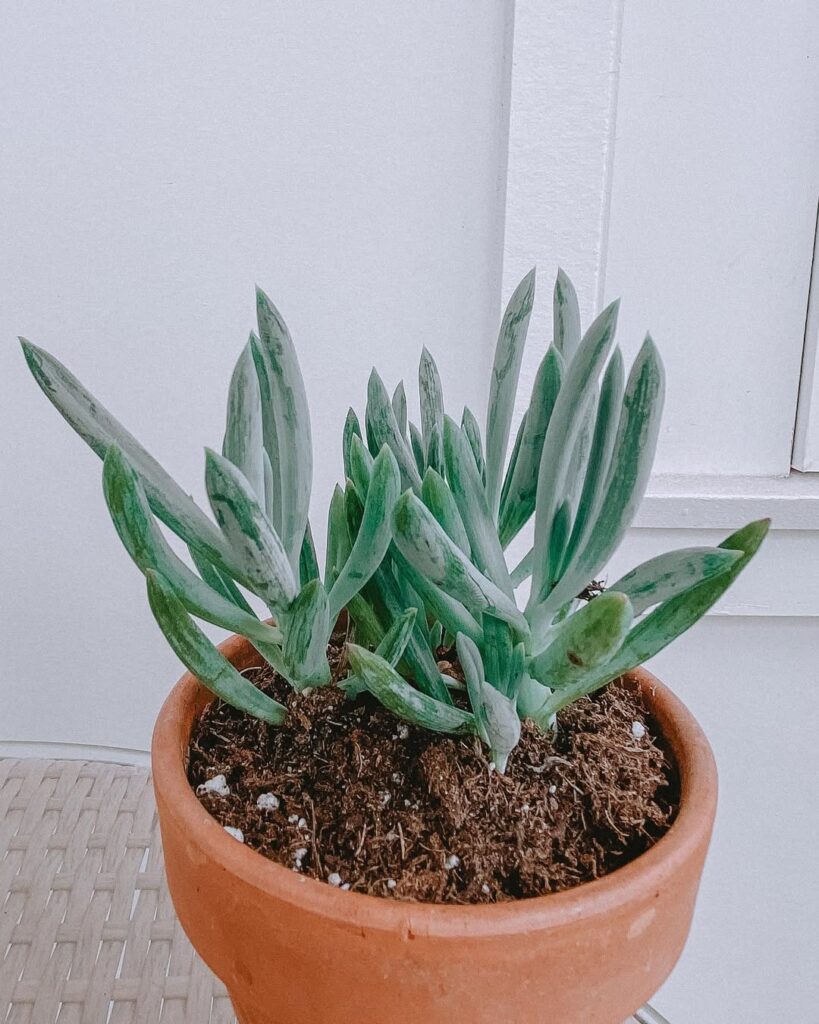
Blue Chalksticks (Senecio serpens) is a low-growing succulent that forms dense mats of silvery-blue, finger-like leaves. This South African native typically grows 6-12 inches tall and spreads horizontally, making it an excellent ground cover or border plant. The cylindrical, powder-blue leaves grow in an upright position and give the plant its distinctive chalk-like appearance. While it rarely flowers, it may produce small white blooms in summer.
- Light: Full sun to partial shade; best color develops in bright light
- Water: Low water needs; allow soil to dry completely between waterings
- Soil: Well-draining sandy or rocky soil
- Temperature: Hardy in zones 9-11; protect from frost
- Fertilizer: Light feeding during growing season
- Container: Suitable for pots with drainage holes
- Propagation: Easily propagated through stem cuttings
- Spacing: Plant 12-18 inches apart to allow for spreading
14. Pincushion Cactus
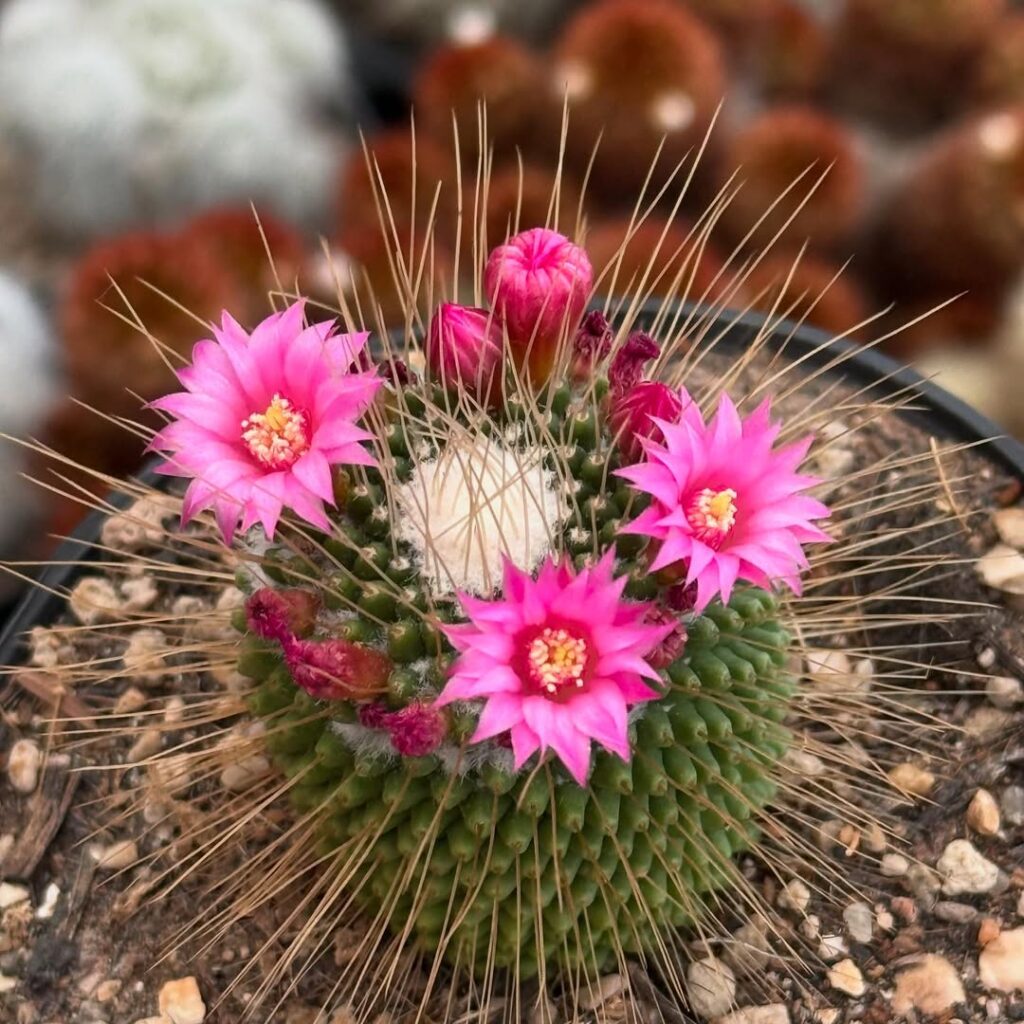
The Pincushion Cactus (Mammillaria) is a small, rounded succulent known for its compact size and distinctive appearance. These charming plants feature densely packed tubercles covered in symmetrical patterns of spines, which can be white, yellow, red, or brown. Many species produce a ring of small, funnel-shaped flowers in pink, white, or yellow hues around their crown during the growing season. Most Pincushion Cacti remain small, typically growing only a few inches tall, making them perfect for windowsills and small containers.
- Light: Bright, indirect sunlight; can tolerate some direct morning sun; protect from intense afternoon sun
- Water: Water thoroughly when soil is completely dry; reduce watering considerably in winter
- Soil: Well-draining cactus mix with added mineral grit or perlite
- Temperature: Prefers 60-80°F (15-27°C); can tolerate brief periods below freezing
- Humidity: Low humidity levels; tolerates average household humidity
- Container: Small pot with drainage holes
- Fertilizer: Feed with diluted cactus fertilizer during growing season (spring to fall)
- Growth Rate: Slow growing
15. Mexican Snowball Cactus
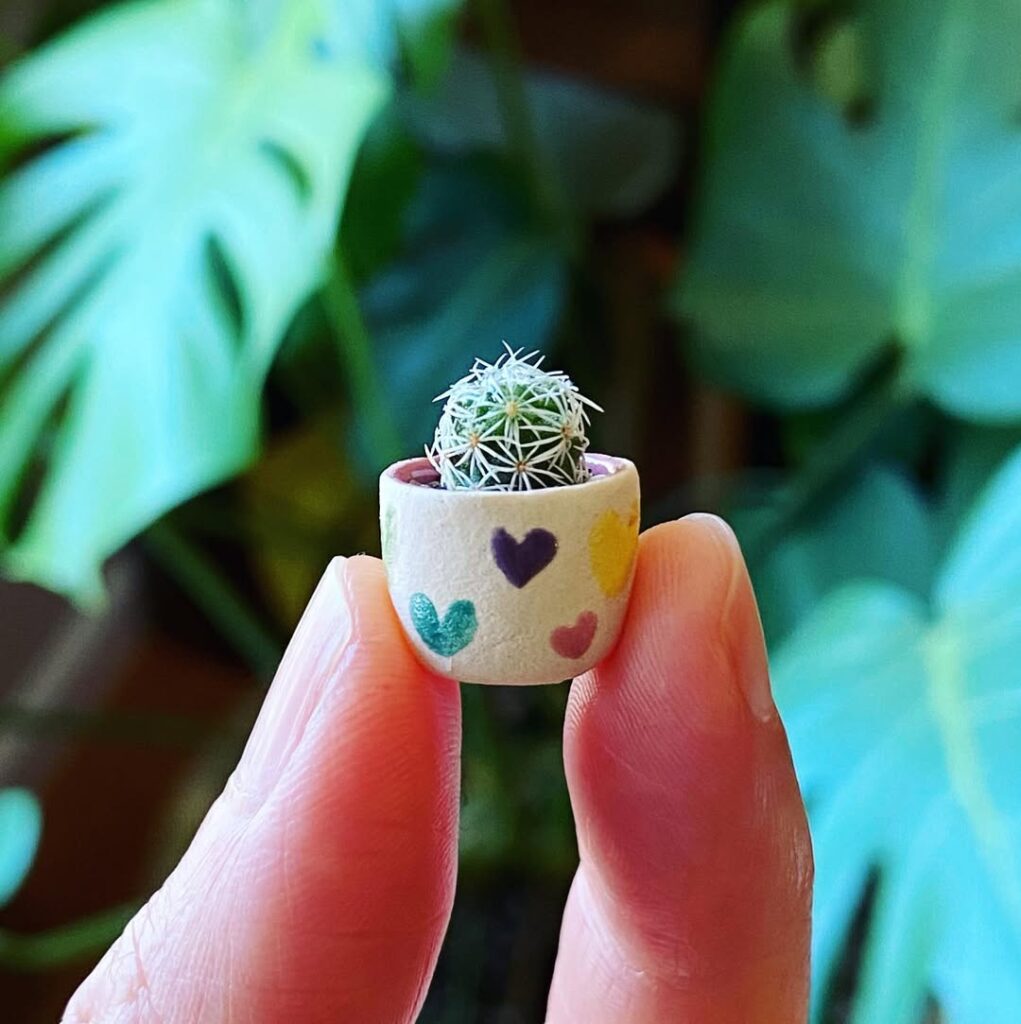
The Mexican Snowball Cactus (Mammillaria gracilis fragilis) is a petite, clustering succulent that forms dense mounds of small, spherical stems covered in white spines, giving it a delicate, snow-like appearance. Each individual stem typically grows only 1-2 inches in diameter and easily detaches from the parent plant, allowing for simple propagation. These miniature cacti produce tiny cream or pale yellow flowers in a ring around the crown during spring and summer, though flowering is somewhat rare in cultivation.
- Light: Bright, indirect sunlight with some direct morning sun; protect from intense afternoon sun
- Water: Allow soil to dry completely between waterings; reduce watering in winter
- Soil: Well-draining cactus mix with added perlite or pumice
- Temperature: 65-80°F (18-27°C); can tolerate brief periods down to 40°F (4°C)
- Humidity: Low to moderate; tolerates average household humidity
- Container: Small pot with drainage holes
- Fertilizer: Light feeding with balanced cactus fertilizer during growing season
